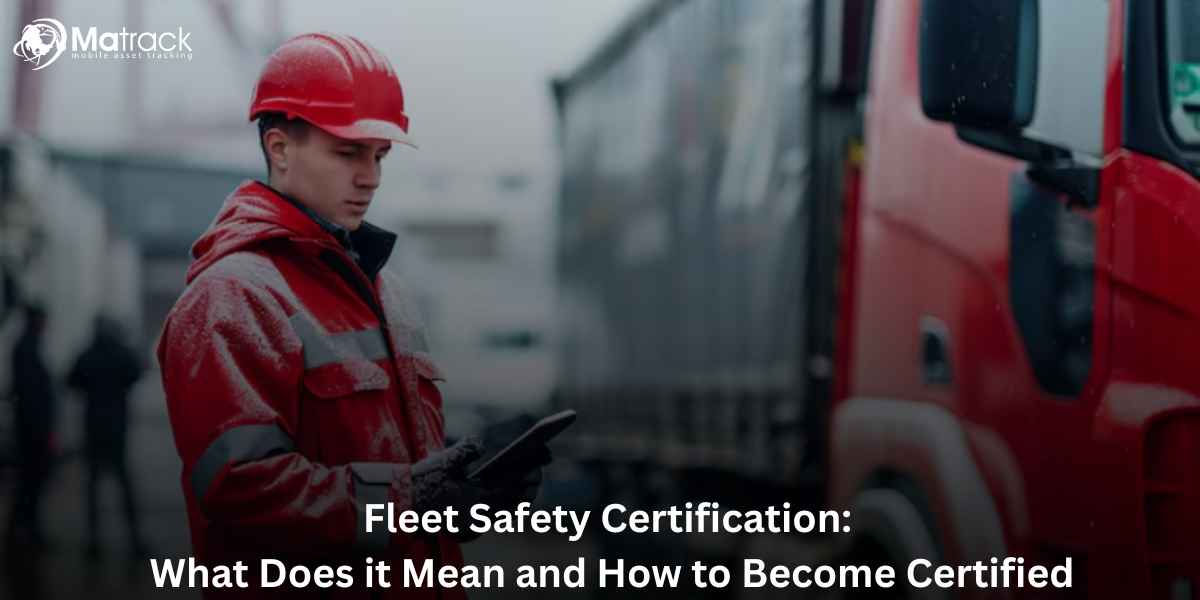Key Takeaways:
- Fleet safety certification proves your vehicles, drivers, and safety systems meet trusted safety standards.
- It helps reduce accidents, lowers insurance costs, and increases client trust in your operations.
- Getting certified involves seven steps including audits, training, technology upgrades, and official review.
- There are six major certification types, each covering different safety needs, costs, and compliance areas.
What Is Fleet Safety Certification?
Fleet safety certification shows that a company’s vehicles follow proper safety rules and practices. It’s given by trusted organizations after checking how well the company trains drivers, manages the fleet, and follows safety regulations.
Getting certified means three main things:
- Vehicles follow safety laws and industry rules.
- Drivers know how to handle risks and drive safely.
- The company keeps track of incidents and handles them properly.
Why Fleet Safety Certification Is Important
Fleet safety certification protects your business by showing that your vehicles and drivers follow important safety rules. It proves that your company meets standards set by FMCSA, OSHA, and DOT.
Certification also saves money by reducing accidents, lowering repair costs, and helping you get better insurance rates. It makes your business more trustworthy and helps you win more contracts.
How to Become Fleet Safety Certified
To get fleet safety certified, a company needs to follow a clear process. There are 7 main steps to complete:
1. Conduct a Fleet Safety Audit
Start with a full check of your safety practices, vehicle condition, and paperwork. This helps spot:
- Safety rule gaps
- Past accidents or incidents
- Driver habits and issues
- Vehicle maintenance problems
This step shows where improvements are needed.
2. Build a Fleet Safety Management Program
Create a clear safety plan that fits your vehicles, drivers, and local rules. A solid plan includes:
- Training schedules for drivers
- Regular vehicle checks
- Emergency action plans
- Steps to handle driver fatigue and distractions
- How to respond to accidents
Use guides from FMCSA, NSC, or ISO to help you build it.
3. Train Drivers and Staff
All drivers and key staff need proper training. Training must cover:
- Defensive driving
- Handling vehicles safely
- What to do in emergencies
- Managing fatigue
Top training programs include:
- NSC Defensive Driving Course
- Smith System Driver Training
- Fleet Response Driver Programs
- Fleet Safety Program
4. Upgrade Technology and Telematics
Add tools that boost safety and track fleet activity. Key tools are:
- GPS tracking for routes
- Dashcams for video proof
- Speed control and braking tech
- Driver behavior tracking systems
These tools show that your safety measures are real and working.
5. Document All Procedures and Results
Keep clear records of everything you do. Certification needs proof of:
- Completed training
- Vehicle maintenance
- Safety inspections
- Audit results
Use tools like Samsara, Verizon Connect, or Geotab to stay organized.
6. Apply for Certification
Pick the right certification provider for your type of work. Common choices:
- National Safety Council (NSC)
- FMCSA (Federal Motor Carrier Safety)
- ISO (International Organization for Standardization)
- Industry-specific bodies (like the Construction Safety Council)
Send in your paperwork, pay the fees, and prepare for a review.
7. Complete the Certification Audit
A safety auditor will check your records, talk to your team, and look at your fleet. If you meet all the requirements, you’ll get certified. Certifications usually last 1 to 3 years. Some require yearly updates.
6 Types of Fleet Safety Certifications
1. NSC Defensive Driving Certification
NSC Defensive Driving Certification is designed to teach drivers how to identify road risks, avoid dangerous behavior, and apply safe driving techniques in real-world scenarios. It’s ideal for companies that want to improve driver behavior and reduce accident rates.
This certification is offered by the National Safety Council and focuses on individual driver skills. It’s a strong starting point for any fleet safety strategy.
- Driver behavior improvement
- Collision avoidance strategies
- Risk awareness and hazard response
- Cost: $40–$75 per driver (depending on course level)
2. DOT Compliance Certification
DOT Compliance Certification ensures that your fleet operations meet the federal rules set by the U.S. Department of Transportation. It is essential for commercial fleets that cross state lines or handle regulated cargo.
This certification checks records, vehicle maintenance, and driver work hours. It helps businesses avoid fines and stay legally compliant.
- Driver qualification files
- Vehicle inspection, repair, and maintenance
- Hours-of-service (HOS) monitoring
- Cost: $500–$2,500 (based on fleet size and compliance needs)
3. Fleet Safety Program Certification
Fleet Safety Program Certification verifies that your company runs a complete and well-managed safety program across your entire fleet. It’s usually provided by third-party safety consultants or insurance partners.
This certification shows your company has a strong culture of safety and clear protocols for preventing incidents. It often includes a full review of safety policies and driver monitoring tools.
- Written safety policies and procedures
- Driver training plans and tracking
- Incident reporting systems
- Cost: $1,000–$5,000 (based on service provider and scope)
4. ISO 39001 Certification
ISO 39001 is a global certification focused on improving road traffic safety through a structured management system. It helps companies set safety goals, track performance, and reduce road incidents over time.
This certification is best for organizations looking to align with international safety standards. It involves detailed planning and ongoing performance reviews.
- Road risk assessments
- Safety performance tracking
- Goal setting and continuous improvement
- Cost: $3,000–$10,000 (based on company size and audit needs)
5. Occupational Safety and Health Certification (OSHA)
OSHA Certification applies when vehicles are part of broader workplace safety programs. It’s important for fleets used in construction, utilities, or field services where vehicle use is tied to job site safety.
This certification ensures both drivers and support staff are protected while working. It links vehicle safety with employee health.
- Vehicle-related hazard controls
- Job-specific safety practices
- OSHA training compliance
- Cost: $500–$1,500 (depending on training scope and industry)
6. Private Label Certifications
Private label certifications are offered by insurers or industry groups for fleets that meet their specific safety requirements. These are often used to reduce insurance premiums and demonstrate extra accountability.
They are tailored to business type and help companies lower risks with insurer-backed safety programs. These certifications are great for getting better coverage terms.
- Custom risk management programs
- Insurance-friendly driver protocols
- Claims reduction strategies
- Cost: $1,000–$4,000 (sometimes discounted with insurer partnership)



